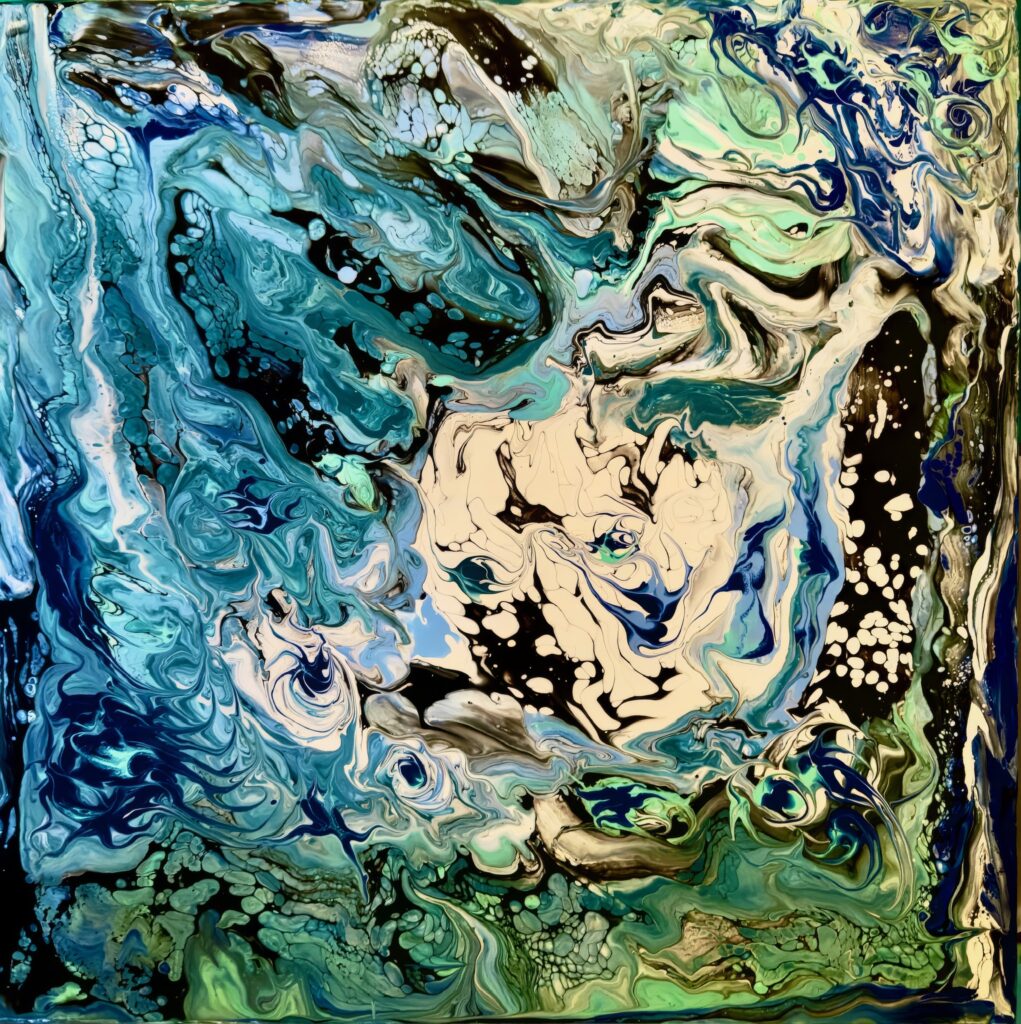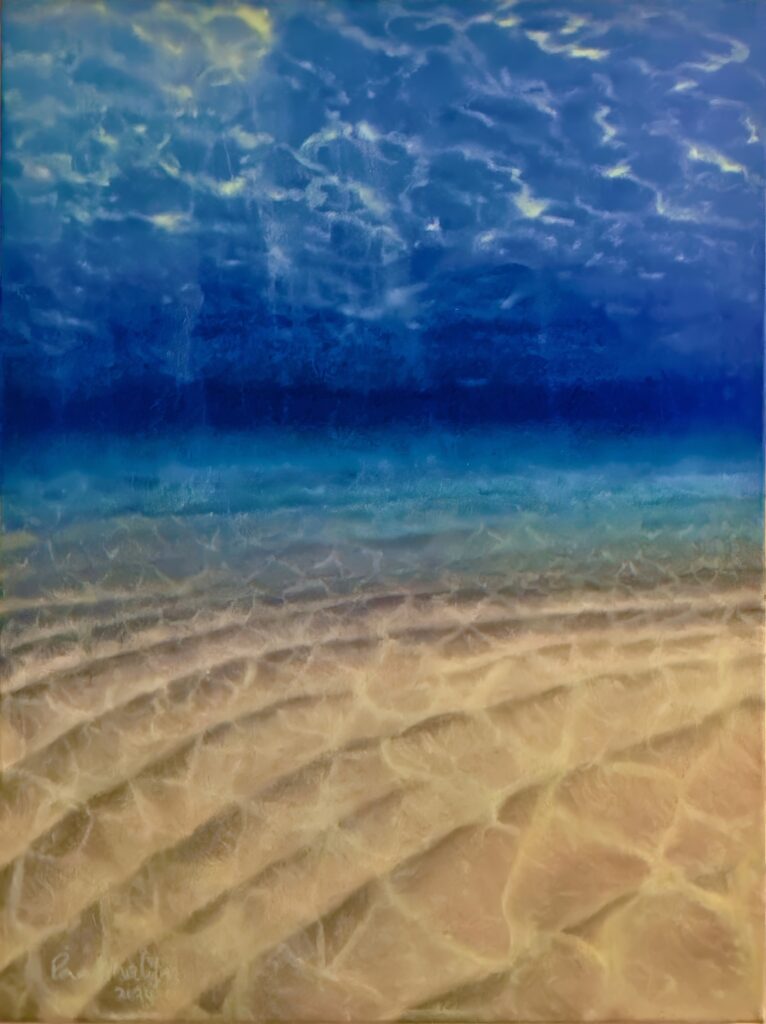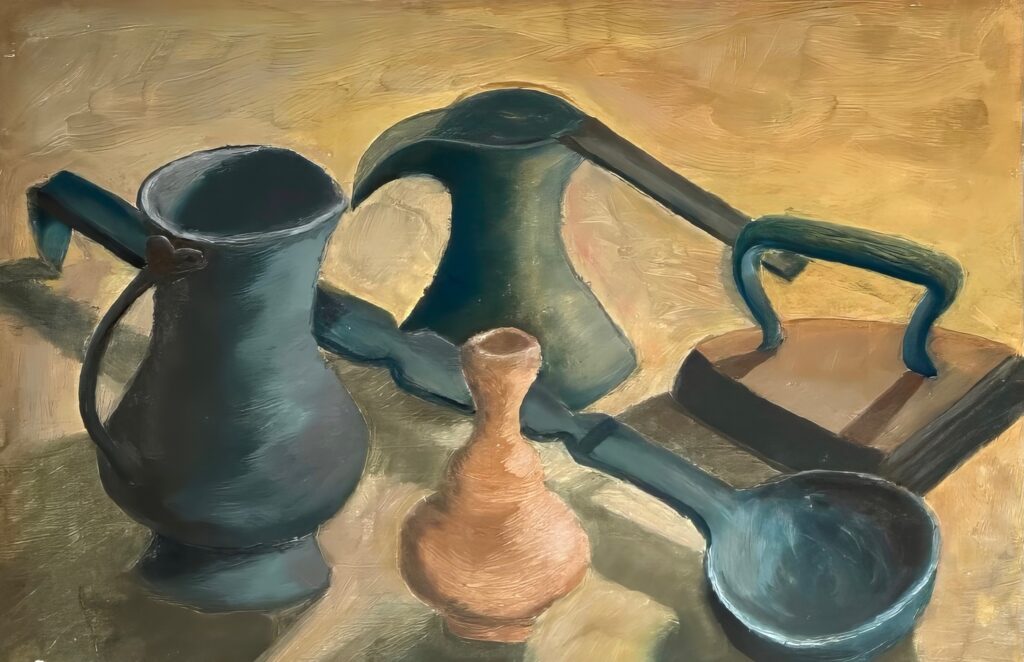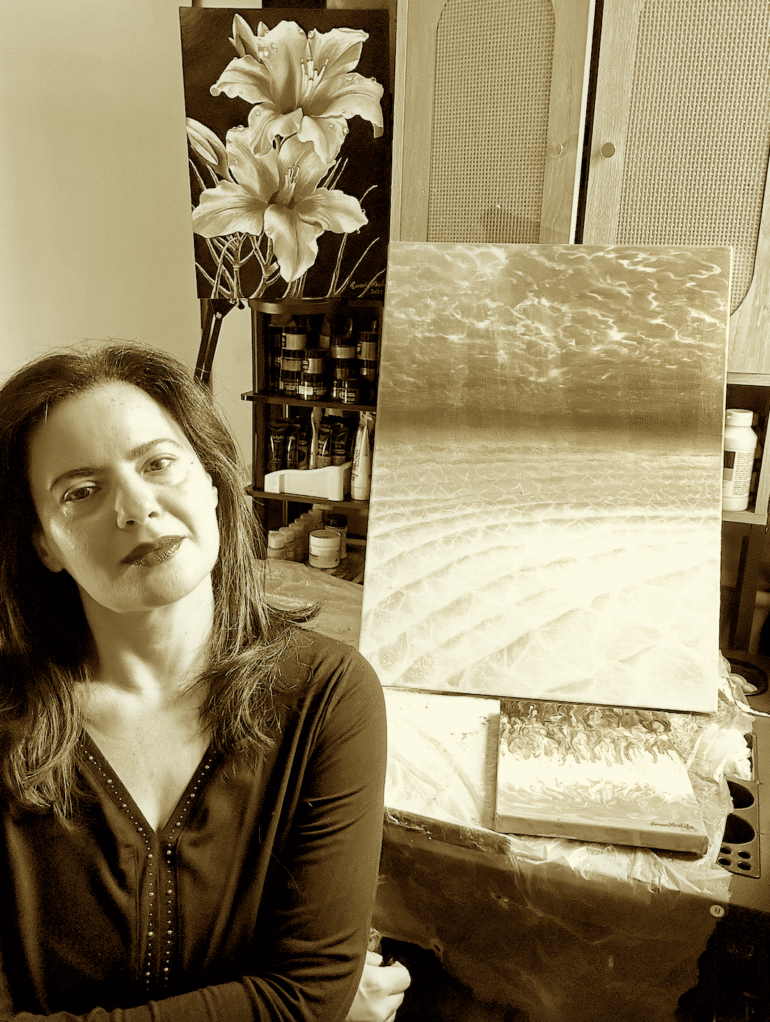Emerging Artist Series
Art, Reimagined Across a Lifetime
In this instalment of Culturalee in Conversation–the first in a new series of interviews with emerging artists–we meet Egyptian artist Eman Khalifa, whose journey to becoming a full-time artist is as layered and expressive as her paintings. A graduate of the American University in Cairo, Khalifa spent over 30 years building a successful business career–all while raising a family as a single mother. But it was her enduring love for fine art that ultimately called her back, and today, she stands at the canvas with renewed purpose and creative freedom.
Khalifa’s artistic voice is marked by striking versatility. She shifts effortlessly between abstraction and figuration, creating works that range from contemplative still life paintings that evoke the quiet harmony of Giorgio Morandi, to expressive florals that channel Georgia O’Keeffe’s reverence for natural beauty. With every brushstroke, Khalifa explores not only visual form, but the life stories and emotional textures that shape her unique perspective.
Join us as we delve into her remarkable second act, the influences behind her work, and the power of returning to one’s passion on one’s own terms.

Your multicultural background-growing up between Egypt and the U.S. and now living in London-offers a rich cultural tapestry. How has this diverse upbringing shaped your creative vision and influenced the way you approach your art?
I do indeed come from multiple cultural influences, and in many ways, I’m a melting pot in my own right. I believe my Egyptian roots instilled in me a strong commitment and work ethic. In Egypt, there’s a mindset of “finding a way” to solve any problem–giving up is simply not an option. This resilience is something I carry into my art. My preference for bold, vibrant colors also comes from Egypt, especially from my childhood by the seaside in Alexandria, where I developed a deep love for the sea. The underwater world there, particularly in Almaza Bay, is one of the most beautiful places I’ve ever seen. The clarity of the water and its turquoise colors are unmatched, and the sunlight there shines differently, making you feel pure happiness. This experience is what I sought to capture in Hypnosis–the memory of being submerged in those waters, feeling both peaceful and energized by the beauty around me.
The love I have for structure and form comes from my father, who was both an engineer and a poet. From him, I learned that it’s possible to be multifaceted–working in both precision and creativity. My mother, a lover of antiquities and jewelry, also played a significant role in shaping my artistic vision. My first still life, Genesis of Form, was an arrangement of oriental antique ornaments she treasured. I painted this during my Fine Art studies at the American University in Cairo (AUC), under the guidance of Paul Rinaldi, an Italian American art professor who recently passed away. His encouragement to explore the works of other masters greatly influenced my artistic journey. The trips to old bazaars and markets during my studies exposed me to a riot of colors and patterns that I still draw inspiration from today, particularly in my use of optical illusions and bold, impactful color choices.
As for my American side, I was deeply influenced by the family ties to the U.S. My parents moved to the States as newlyweds, and my three older sisters were born and raised there. Growing up, I spent many summers in California, where I was exposed to American culture and art, especially the vibrant colors that defined the West Coast. I think that influence is why, when you look at my work–apart from the Orientalist still lifes–you might feel that it leans more Western than Eastern. In my fine art studies at AUC, I also had an American teacher, which further shaped my approach. That influence is clear in my bold use of colors, which I think stems from the California aesthetic, with its Latin-inspired vibrancy. The colors I use in pieces like Desire reflect this influence, a fusion of Western energy with the detail-oriented style I learned from my Egyptian upbringing.
However, my connection to the U.S. isn’t only about color and vibrancy. It also shaped my work ethic and my approach to life. My father’s precision, steadfastness, and commitment to excellence were qualities I admired and adopted. He was a master of many disciplines, having earned multiple degrees–first in engineering, then finance, and eventually becoming a successful entrepreneur. He taught me the importance of diligence and excellence, lessons I applied to my work as well as my career in business. I spent six years working with him, learning immensely from his brilliant mind. Despite my business career–where I held senior positions at companies like Procter & Gamble, Microsoft, and HSBC–I found time to open The Art Room, an art gallery in Cairo that I ran for a while, selling work by myself and other young artists. But when I became a mother, my focus shifted, and I had to step away from my gallery to juggle my career with motherhood.
After reaching a stage in my career where I had achieved significant success, I began to feel a paradoxical emptiness that led me to question my path. Despite all my professional accomplishments, I felt as though something vital was missing. That’s when I realized it was time to finally listen to the voice that had always been there, quietly urging me to embrace my true passion–art. I chose to honor that voice and make the leap into the world of painting, something I had always dreamed of but never fully pursued.
I moved to London during the financial crisis, which severely impacted the Egyptian economy and acted as a catalyst for the 2011 Egyptian revolution, driven largely by widespread economic hardship, more than anything else. During that turbulent time, I decided to explore new career opportunities outside of Egypt to broaden my horizons. So I transitioned into the field of Talent management, where I led HSBC’s diversity and inclusion programs with a focus on senior gender diversity and HR analytics straight from HSBC’s headquarters at Canary Wharf in London. Though I initially planned to stay in London for just a few years, life had different plans.
Here, I met my husband, Francois. And my daughter, Malak-Indigo (who has since become an artist in her own right as a music producer), found a life she truly loved. As a family, we decided to make London our permanent home. Over time, my career shifted from corporate leadership to the art world, and now, with more time and space, I am fully embracing my artistic journey.
London has given me the opportunity to merge the influences of Egypt, the U.S., and now, the UK, into my work. It’s a place where I can bring together these rich traditions and perspectives, allowing me to explore and express them in my art in ways that feel true to me. My work continues to evolve as I find new ways to fuse the vibrancy of my past with the energy of the present.

You made a bold move, leaving a successful corporate career to fully embrace your artistic path. What sparked that decision, and how has returning to your first love of painting transformed your life and practice?
I’ve always dreamed of leaving the business world behind to return to my true love–art. However, there was always something holding me back. For many years, that something was the responsibility of being a single mother, carrying the financial burden for both my daughter and myself after my divorce in Egypt. That stability required a steady income, and while I longed to immerse myself in my art, the reality of life made it feel impossible. It was as though I was separated from my true self by an invisible glass wall. I could see my art on the other side, but I couldn’t break through, much like a dream where you want to run but are paralyzed by an invisible force.
The feeling of being disconnected from my true identity was agonizing. Over time, as I climbed the corporate ladder, I reached the highest levels of achievement, but paradoxically, that success led to an overwhelming emptiness. The silence of success began to ring in my ears. It’s a silence that, when experienced long enough, becomes deafening. The metaphor behind my still life, Weight of Silence, speaks to this sensation. Silence truly does have weight. When all is quiet, it allows you to hear more clearly—the sound of your soul, your dreams, and your true desires.
Living in a world of structure–black and white, heavy and lifeless–mirrored the feelings I had at the time. I was overwhelmed by a weight that wasn’t just the heaviness of my work but the weight of being disconnected from myself, from my art. It was the weight of structure without color, the weight of existing without embracing your soul’s calling.
As time went on, I could no longer ignore this feeling. When an internal restructure at my workplace presented me with the choice of either stepping into a more complex role or finally honoring myself, the decision became clear. I chose to honor my true self. With the business skills I’ve developed over the years, I knew I could manage alternative income sources to sustain myself while I focused on art and allowed myself to fully evolve into the artist I was always meant to be.
That decision in October 2024 marked the turning point. Since then, I’ve created seven new pieces–each requiring immense commitment. It was as if a floodgate had opened, and my creativity began to pour out. Works like Desire, Hypnosis, River Melody, and Tectonic emerged with a raw, uninhibited energy, and I feel I’m only just getting started. The creative momentum hasn’t stopped, and it’s truly been a transformative and liberating experience to finally follow my artistic path.

Your work moves fluidly between abstraction and figuration, from quiet still lifes to evocative florals. Who or what would you say are your greatest influences, and how do they manifest in your work?
To be honest, even my influences are a melting pot, shaped by my experiences and the environments I’ve lived in. My earliest influences came from the streets, markets, and bazaars of Cairo, where the rich colors and intricate patterns of Islamic art and architecture first captured my imagination. The golden sunsets and vibrant hues of both Alexandria and California also play a significant role in my color palette, reflecting the colorful landscapes and atmospheres I’ve experienced in those places.
During my Fine Arts studies at university, I was fortunate to have the late Paul Rinaldi as a tutor. He introduced me to a wide range of artists and art styles, nurturing a sense of exploration and adventure that fit perfectly with my own love for experimentation. He encouraged me to look beyond the conventional, and that’s something that continues to shape my approach today.
The greatest influence, however, came from Caravaggio–the grand master of chiaroscuro. His dramatic use of light and dark, which imbued his works with both depth and tension, speaks to my own fascination with the power of light and color. Like Caravaggio, I am drawn to the dramatic and the flair that light can bring to a piece. It’s why I often focus on light, color, structure, depth, and weight in my work, almost as if I’m addicted to these elements. I could spend days experimenting with the creation of color and illusion, using shape and color juxtaposition to orchestrate the perfect harmony of hue.
Other influences that have shaped my work include Giorgio Morandi, whose still lifes teach me about the quiet power of structure and simplicity, and Georgia O’Keeffe, whose bold, sensual approach to color and form has inspired my own florals. The emotional depth and color fields in the works of Mark Rothko also speak to me, especially in how color layering into simple shapes can communicate directly to the viewer’s emotions without the need for realism or intricate detail.
I was deeply influenced by Vermeer for his masterful use of color and light. From him, I learned that shadow doesn’t always arise from adding black or white; instead, it can emerge through the juxtaposition of cool blues and greens against warm reds and soft yellows. This interplay of colors creates form and luminescence, a lesson that profoundly shaped my approach. It was Cézanne, however, who inspired me with the idea that all forms in life can be distilled into shapes, if one chooses to see them that way.
David Hockney is a living artist who is a constant source of inspiration for me, particularly in his use of vibrant color, his boundary-pushing experimentation with different mediums, and his exploration of perspective.
Modern acrylic pouring has become a powerful influence on me, particularly for its emphasis on fluidity, spontaneity, and the exploration of color dynamics. The unpredictable nature of pouring–where color blends and forms emerge unexpectedly–resonates with my own love for experimentation and embracing the unknown. It allows for a sense of freedom, much like my approach to layering color and structure, and brings a fresh perspective to how I view composition.
All these influences combine in my work to create a constant interplay between structure, color, and light–each of them a lever I can’t resist pulling in the ongoing experiment of creating and capturing something that feels both personal and universal.
You’ve described your process as organic and “almost alchemical.” Can you talk us through the creation of one of your abstract works-such as Hypnosis – and what materials, inspirations, or internal states guide you from beginning to end?
The alchemical aspect of my process lies in the experimentation with color, especially when using mica pigment powders. I’m exploring the idea of eventually creating my own paint brand, one that focuses on crafting colors designed to reflect emotions and evoke specific feelings through thoughtfully curated color combinations. For me, color is not just an artistic tool, but a medium for transformation. My experimentation has led me to discover shades that defy expectations. For example, through blending metallic bright orange (amber) with metallic bright green (chartreuse), I created a gold that seemed almost magical. At a time when many artists are spending considerable amounts on gold paint, I found myself producing it in my own studio through pure experimentation.
Intrigued by the unexpected results, I continued exploring non-complementary color pairs. Mixing metallic bright green with metallic purple yielded silver–another revelation. This process confirmed that color, for me, is synonymous with alchemy. It’s not just an art form; it’s a science, with its own rules and logic. The way the colors of the rainbow refract through crystal is an amalgamation of white light, and when primary colors are mixed in equal proportions, they result in black. In this sense, the science of color feels like something the ancient alchemists would have cracked in their quest to create new substances and materials. This scientific logic, combined with the endless possibilities of color, is what draws me in.
With Hypnosis, I began by layering deep ultramarine, gradually adding small amounts of yellow to see how the color evolved, all the way to a crystal-like white, with just a hint of yellow. This process mimicked the reflections of sunlight on the water’s surface and the ripples of sand beneath. The deepest blue, reserved for the center, served as the vanishing point, drawing the viewer into the depths of the ocean. The turquoise hues I created by mixing blues and yellows myself (not from a tube) form the beautiful transitions toward the shallows of the shore, capturing the underwater beauty of Almaza Bay in Alexandria, where I spent many precious moments. This blending of color was not only a technical experiment, but a personal journey into recreating the stunning, vivid memories of the sea.
Is there a message you hope viewers take from your work-particularly the abstract pieces? Do you see your paintings as a form of meditation, and do you hope they offer something universally resonant, regardless of background?
When I step back and look at my body of work, I realise that what connects even my most diverse pieces is a desire to share a moment of awareness–of a thought, an emotion, or an experience. I see art as a powerful mode of connection and communication; a single image can evoke memories, feelings or questions that sometimes elude words. Sometimes that’s the awe I feel standing on a riverbank at dawn in River Melody, the raw energy of a storm in Thunder, or the quiet intimacy of two vessels leaning toward each other in Still Longing. In the abstracts, I’m not trying to illustrate an object so much as the pulse of life in Organic Life, the tension of change in Edge of Calm, or the human resilience embedded in Patchwork Village: Palestine in Memory.
The process itself is meditative. Whether pouring paint to mimic the drift of tectonic plates in Tectonic or placing collage elements like stitches in The Hearth Quilt, I’m fully present and listening to what my inner voice is telling, and my desire to convey it to connect with others on a human, sometimes intimate level. I hope that invites viewers to slow down and find their own stories in the rhythm of lines, colours and textures. If someone from a completely different background can look at Golden Fracture and see both fragility and harmony or lose themselves in the depth of Hypnosis and feel peace, then I’ve done what I set out to do. Ultimately, I want each painting to offer a universally resonant space where personal memories, emotions and questions are welcome.
What exhibitions do you have coming up that you would like readers to know about?
I’m fortunate to be currently exhibiting in Vogued at Boomer Gallery in London, and Land, Sea & Sky at Fronteer Gallery in Sheffield.
Upcoming planned exhibitions include; Untitled Artists Fair, London (September 2025); SPIRA9 with London Design Festival/ Architectural Heritage Fund/ Arts Council England and Frieze – in the Everything Then is No Exhibition(September 2025); Shadow & Shade virtual exhibition at BobCat Gallery, (6-31 October 2025); Artist Talk Magazine Digital Exhibition in the London Underground during Frieze London Art Week (10-12 October, 2025), where I will exhibit Desire at Oxford Circus station, Hypnosis at Leicester Square Station and Tectonic at Liverpool Street station; Espacio Gallery, Shoreditch, London (14 October 2025); and ING Discerning Eye Exhibition at The Mall Galleries (London, 14–23 November 2025).
All images Courtesy of Eman Khalifa.
Find out more about Eman Khalifa at: https://emansgallery.com



